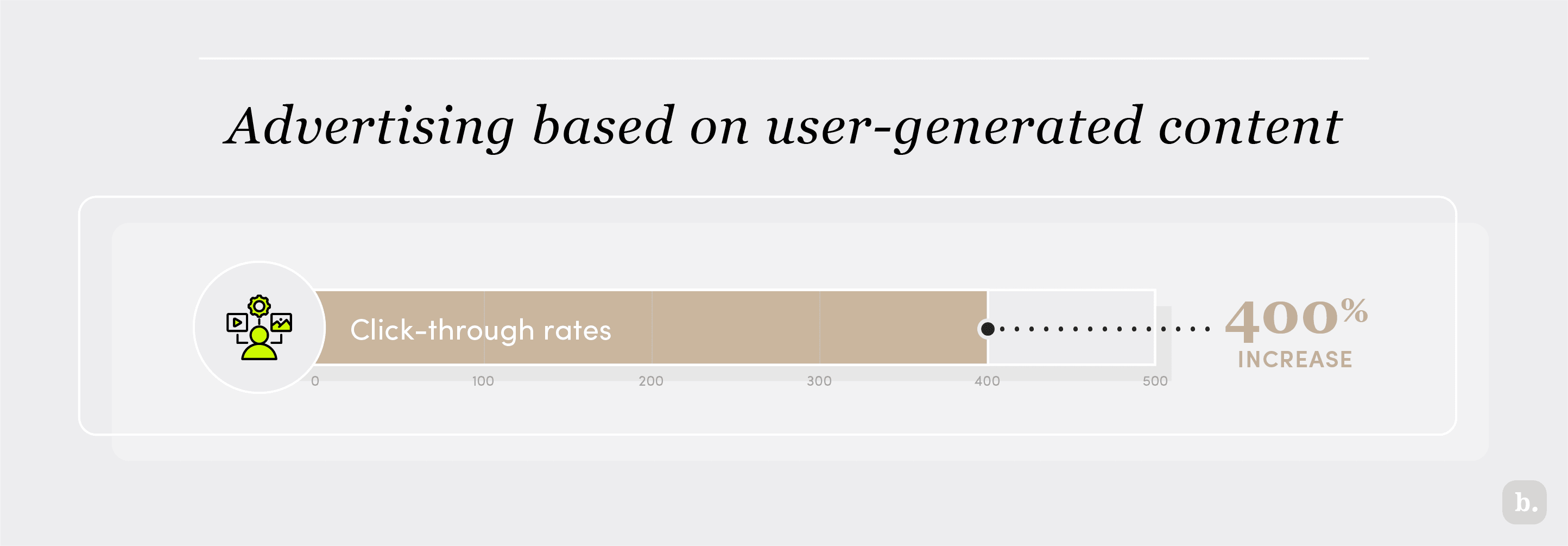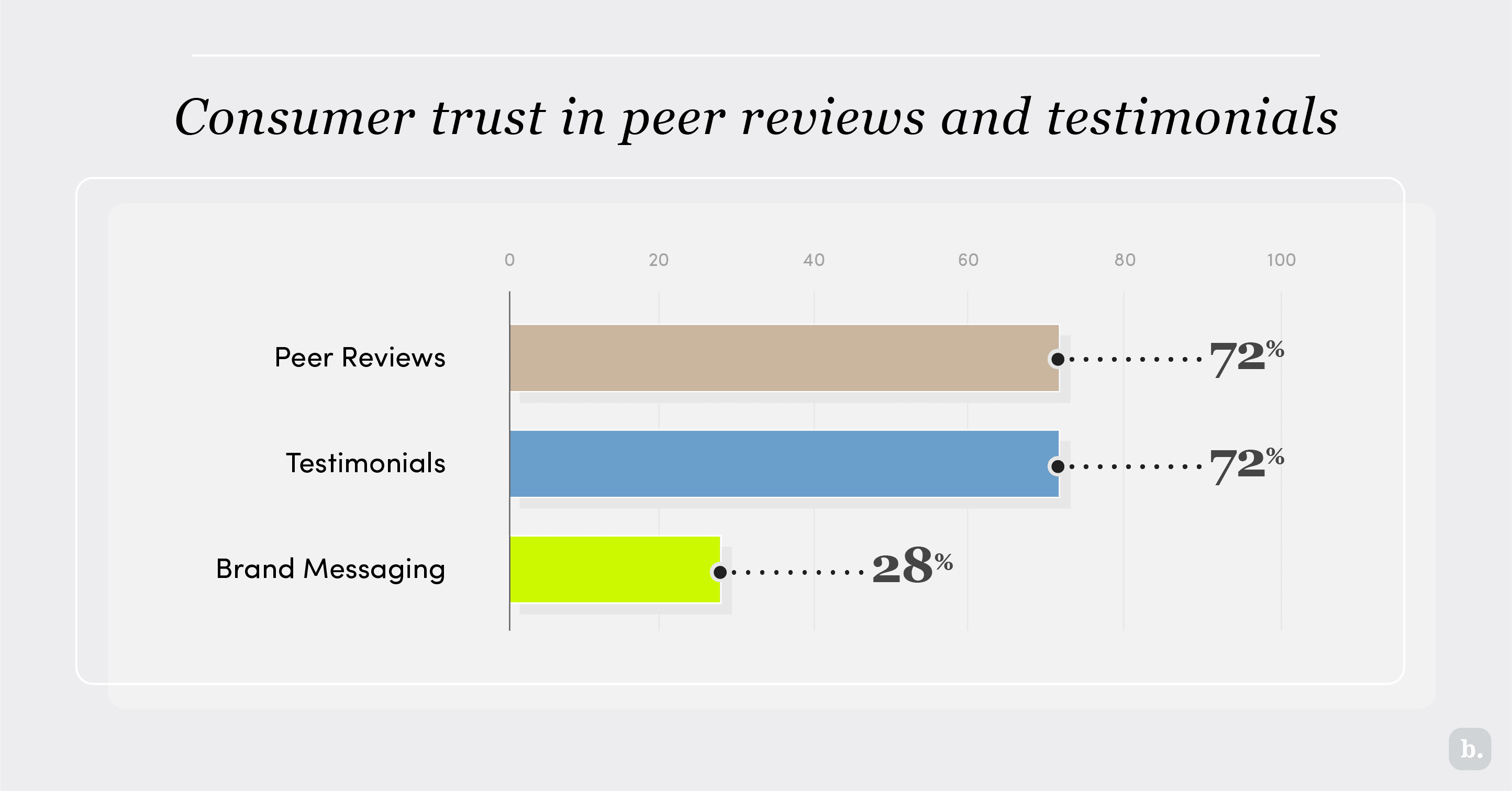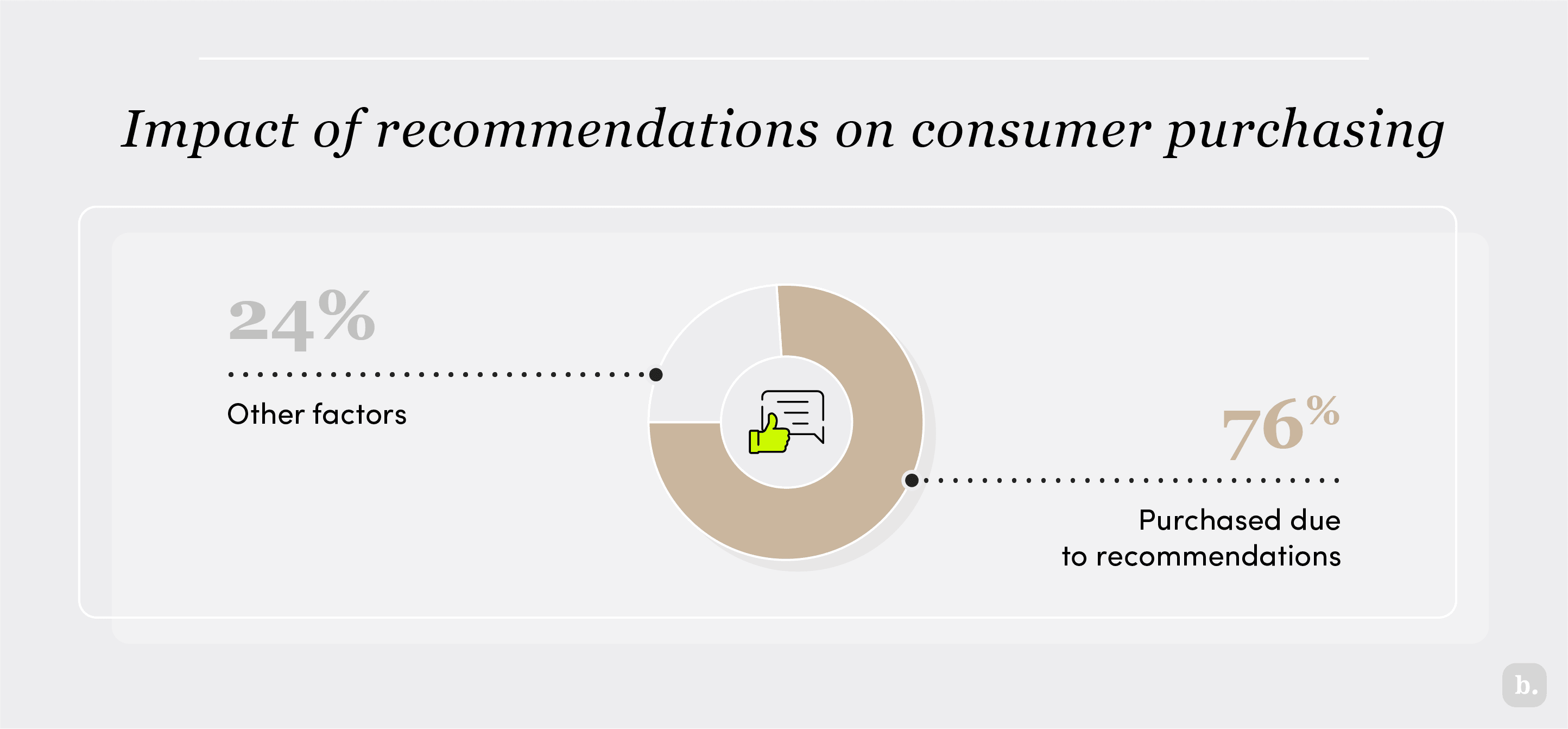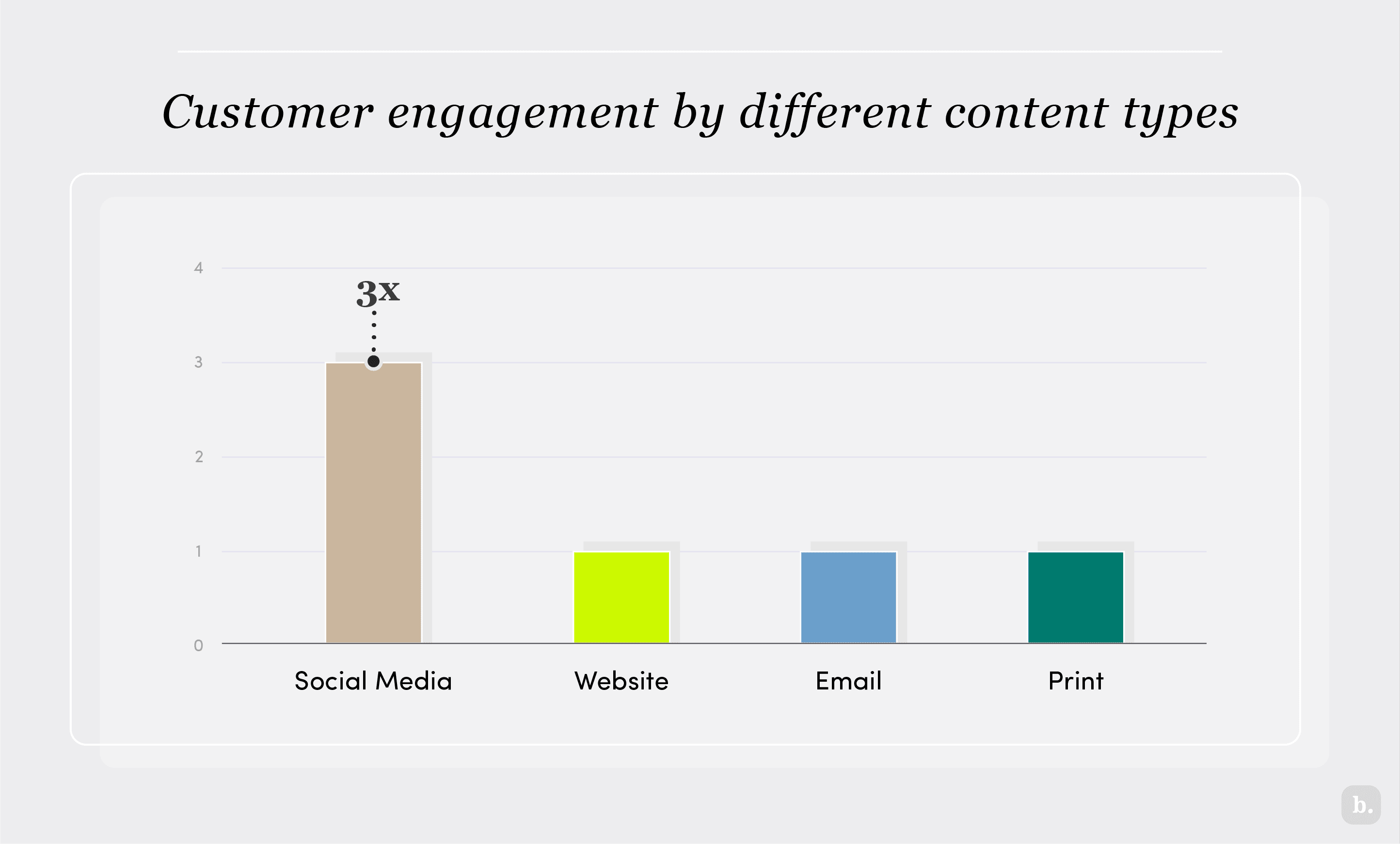Business.com aims to help business owners make informed decisions to support and grow their companies. We research and recommend products and services suitable for various business types, investing thousands of hours each year in this process.
As a business, we need to generate revenue to sustain our content. We have financial relationships with some companies we cover, earning commissions when readers purchase from our partners or share information about their needs. These relationships do not dictate our advice and recommendations. Our editorial team independently evaluates and recommends products and services based on their research and expertise. Learn more about our process and partners here.
User-Generated Content: More Than Customer Reviews
User-generated content (UGC) can help your brand engage customers and boost sales. Learn how to encourage user-generated content to increase trust, engagement and sales.

Table of Contents
User-generated content (UGC) is an excellent strategy for gaining exposure for your brand and showcasing content from your customers. User-generated content is more than just customer reviews; innovative marketing teams are finding ways to leverage user content effectively to build a bigger brand, boost their online reputation, generate sales leads and increase sales.
In today’s digital landscape, user-generated content has become more powerful than ever. Recent research shows that 93 percent of marketers said user-generated content performs notably better than traditional branded content, with brands using user-generated content seeing 29 percent more web conversions.
We’ll explore user-generated content and its benefits and then share how to build an engaging marketing plan and sales process incorporating user content.
What is user-generated content?
User-generated content is content that customers generate about a specific brand. User-generated content can range from positive customer reviews posted on sites like Google and Yelp to deep-dive videos on products and services. Audiences consider user-generated content authentic because the opinions expressed are free of commercial interference, making them trustworthy.
Think of user-generated content as a digital version of word-of-mouth advertising. This is a powerful marketing tool for any business because people trust other people’s experiences and consumers can glean real-life insights and opinions about your product or service through user-generated content.
While it’s something we associate more today with social media, the user-generated content era began way before YouTube and Instagram with blogger site reviews.
What are different types of user-generated content?
The three forms of user-generated content are:
- Written content: Reviews, comments, testimonials and social media posts
- Visual content: Images, photos, graphics and infographics
- Audio and video content: Video reviews, unboxing videos, tutorials and podcasts
Video and audio user-generated content is nearly always accompanied by explanatory written content to provide context to your user’s audience.
Feedback by other users to existing user-generated content on your products, services and brand can also be considered as user-generated content.
Where does user-generated content appear?
You are most likely to see user-generated content on:
- Social media platforms, such as Instagram, TikTok, Facebook, YouTube and LinkedIn. TikTok and Instagram have become primary destinations for product discovery, with consumers now heading to these platforms for product reviews before making purchases.
- Review sites, like Google Reviews, Yelp and Trustpilot
- Company websites and product pages
- Email marketing campaigns
- Online forums and communities
Related article: Best Practices for Posting on Instagram
What are the benefits of user-generated content?
User-generated content is a powerful and effective tool when used as part of your overall marketing strategy. Some brands are wary of user-generated content because consumers have the power over the actual content generated. However, with the right strategy and framework, user-generated content can benefit your brand massively and add to your content marketing library.
Recent research shows the following enhanced user-generated content benefits:
Higher engagement and conversion rates
Advertising based on user-generated content can result in a 400 percent increase in click-through rates, according to JoinBrands. Additionally, Bazaarvoice found that user-generated content increases conversions by 161% when included on e-commerce product pages.

Improved social proof
Seeing user-generated content in their social media feed or an email newsletter prompts consumers to interact in greater numbers because they appreciate and engage with content from people like them. This, in turn, makes your brand and products more relatable and trustworthy.
Better performance metrics
Power Reviews reports an 8.5 percent increase in conversion rates for website visitors that are served user-generated content ― and a 100.6 percent conversion lift if they interact with the user-generated content. In this context, interacting means that when a visitor to your site is on a shopping page, they read through customer reviews, scroll through a carousel of user-submitted images, zoom in on an image for a closer look and so on.
This demonstrates the importance of user-generated content in building social proof for your brand. This gives potential customers a reason to do something or make a decision based on identifying with and trusting the person delivering the message. Social proof is one of the main reasons why influencer marketing works so well.

Increased return visits
Featuring user-generated content across your site can result in a 20 percent increase in returning visitors. This is likely because your target audience recognizes your site as a place to find the views and opinions of their peers.

Enhanced brand trust
Tint says 72 percent of consumers trust peer reviews and customer testimonials on a brand more than the brand’s advertising messages. EnTribe‘s report also supports this. It shows that 90 percent of consumers want to see brand content from existing customers and that 83 percent are more likely to purchase from brands that share authentic user-generated content.

Improved brand authenticity
User-generated content is key for building brand authenticity. In a recent S&P survey for 451 Research, 62 percent of consumers believe that user-generated content is a key way of enhancing brand authenticity, vital for effectively telling your brand’s story.
Consumers value user-generated content because it feels unscripted and honest, quite separate from the polished and refined marketing messages they’re used to receiving.
How to generate and showcase user-generated content
To generate and distribute user-generated content to increase your social media subscribers, drive additional traffic and sales to your website and engage consumers more, follow these steps.
1. Encourage customer reviews
Seventy-five percent of users say they look for customer reviews on a product or service before making a purchase. Reflecting their importance, some customer relationship management systems now have online review management platforms that let you prompt customers to leave a review of your business on Google, Yelp and other sites. Check out our review of Podium to find out how to manage online reviews with that app.

Adding a Google Review link directly to your email signature and putting one on your invoice to prompt customers into action are other ways to encourage customers to leave feedback. You could also place a QR code in your store or on your website that connects to your Google Review link.
When someone posts their opinion on your business, make sure you respond to their online review. BrightLocal reports that 89 percent of potential customers state that if a local business responds to online reviews, they are “fairly” or “highly” likely to want to buy from them.
Another approach you can take is to embed reviews on your website. There are plug-ins that pull reviews from Google, TripAdvisor and other platforms directly to your site. Many website platforms now allow your customers to comment on an item they’ve purchased, which will then appear on the particular product or service page for other visitors to read.
Learn more >> 10 Ways to Get Good Customer Reviews
2. Encourage customers to create user-generated content images and video and promote the content
Customers are nearly three times more likely to engage with a brand’s social media than any other content type.
The EnTribe survey found that more than half of Gen Zers actively want to be featured on their favorite brand’s social media pages. Eighty percent report that they have shared or would share the purchases they’ve made on social media with others.
[Related article: How to Build a Brand That Attracts Gen Z and Millennials]

To encourage your customers to take part, create a unique brand hashtag that customers and followers can use in their posts ― this makes it easier for you to spot user-generated content content about your business. Sixty-four percent of consumers have tagged a brand on social media.

You can also try campaign-specific hashtags for something more targeted. For example, if you run a gym or are a fitness consultant, you could encourage clients to post their stories and images about working with you. Something like a “before and after” image-based campaign could be highly effective.
TikTok has emerged as a particularly powerful platform for user-generated content campaigns. A Realeyes study found that user-generated content on TikTok is 22 percent more effective than brand-created videos, with creator-based Spark Ads outperforming regular ads with a 30% higher completion rate, 142 percent more engagement and a 43 percent lift in conversions, according to data from Statusphere. Consider developing TikTok-specific campaigns that leverage the platform’s unique features like duets, challenges and trending sounds.
For your most enthusiastic contributors, ask them to be featured in a showcase or testimonial to give followers a chance to share their journey with your followers. You could also use user-generated content images and videos on your website to demonstrate to visitors that they’re part of a wider and happier community of customers.
Incentivize your audience to join in with your campaigns by offering them freebies, discounts or other appealing prizes.
3. Reach out to bloggers and vloggers
Look for bloggers and vloggers whose demographics are similar to yours and where featuring or reviewing your product would be consistent with other content on a website or video channel. This is an effective way of reaching your target audience as well as using the influence these creators have over their followers for your benefit.
Send an email or message to the creator to offer them the chance to review and then share their honest opinion about your product. Their audience appreciates their style and method of delivery so resist the urge to insert yourself in the editorial or production process for the blog or video.
There is no guarantee, of course, that their review will be favorable. Either way, make sure you’re available to interact with people who read the blog or watch the video to answer their questions about your product. If the review is positive, you may wish to consider using some or all of it in your marketing campaigns.
4. Build brand communities
Brand communities are growing in popularity and are a highly reliable source of user-generated content for your company.
Your brand community could be centered on a Facebook page or an email newsletter. Better still, if you have a large enough audience, create an invite-only forum where, after making a purchase, customers get access to an exclusive, members-only online discussion site where they can meet and interact with you and each other.
Run polls, competitions and other incentives to encourage increased participation and discussion between members to reinforce the feeling of community among your client base. Ask members to get involved in designing your next product or advertising campaign to increase the sense of belonging and brand loyalty.
Some firms even successfully use their community discussion forums to answer new customer’s questions about your products and services.
Legal and compliance considerations
Understanding the legal landscape surrounding user-generated content is crucial for businesses to avoid potential issues:
FTC guidelines: The Federal Trade Commission requires clear disclosure when user-generated content is used in advertising. If staff or brand representatives leave reviews, you must disclose their material connection to the brand. For social posts, creators should use hashtags like #ad or #sponsored. For video content, disclosures must be clearly stated in the video itself, not just in the description.
Copyright gonsiderations: In most cases, the person who creates the content is the initial owner of the copyright. This means content creators have exclusive rights to reproduce, distribute, display and perform their work. Businesses must obtain permission before using user-generated content in marketing campaigns.
Permission requirements: Always secure explicit permission before using user-generated content. You need to ask the creator, and if the content involves other people, ask them as well for permission. This is especially important when the content will be used commercially or distributed widely.
Privacy Considerations: Be mindful of privacy laws like GDPR, which requires opt-in consent to process user content for new purposes. Using a customer’s review for ads without first gaining additional consent beyond the website’s terms of service is prohibited.
User-generated content management tools and platforms
Effective user-generated content management requires the right tools. Here are some top platforms:
Comprehensive user-generated content platforms
- Flowbox: Advanced user-generated content platform with AI product recognition, rights management, and analytics
- Bazaarvoice: Specializes in reviews, ratings, and visual user-generated content with e-commerce integration
- TINT: Enterprise-level platform for discovering, securing rights, and repurposing content
Social media-focused tools
- Taggbox: AI-powered platform for collecting and displaying user-generated content across marketing channels
- EmbedSocial: Combines review management with social media aggregation
- Pixlee TurnTo: Community-driven commerce platform for social user-generated content and influencer marketing
Creator collaboration platforms
- Insense: Connects brands with 20,000+ micro-influencers for user-generated content creation
- Billo: Specializes in creator videos optimized for paid social channels like TikTok and Meta
- Showcase: User-generated content marketplace focusing on high-quality content creators
Analytics and measurement tools
- Yotpo: Customer review platform with visual user-generated content and loyalty features
- Dash Hudson: Social media analytics with user-generated content performance tracking
- Curator: Content curation and engagement tracking platform
How to measure user-generated content performance
To maximize the impact of your user-generated campaigns, track these essential metrics:
Engagement metrics
- Click-through rates (CTR)
- Engagement rates (likes, comments, shares, and overall interaction)
- Time on site
Conversion metrics
- Conversion rates
- Revenue per visitor
- Average order value
Brand Awareness Metrics
- Reach and impressions
- Brand mention tracking
- Hashtag performance
Best practices for user-generated content
When generating and distributing user-generated content for your company, be sure to follow these best practices.
Always ask for permission
Even though you may be soliciting content from your customers and followers, they own whatever they create. So, before reposting it on your own channel or using it in a paid marketing campaign, make sure you have their legal permission to feature their content.
Give credit where it’s due
When sharing text, images, videos or audio created by customers and users, be sure to credit them. This is not only good manners ― your contributors may also want the content they create to be associated with them directly among the wider community.
Moderate comments
If you’re republishing user-generated content on social media or a video-sharing platform, other users can comment on what your customers and followers have created. Although the vast majority of feedback is likely to be supportive, monitor comments regularly to protect the feelings and identities of your contributors. If you need to, shut down the ability for others to comment.
Stay true to your brand
You know more clearly than anyone else the type of content that’s right for your brand. Make sure you only distribute user-generated content that is consistent with your company and its identity.
Other aspects to consider include:
Handling negative user-generated content
- Respond promptly and professionally to negative reviews or comments
- Use negative feedback as an opportunity to demonstrate customer service
- Monitor brand mentions across all platforms to catch issues early
- Develop response templates for common negative scenarios while maintaining authenticity
Take quality control measures
- Establish clear content guidelines for what types of user-generated content align with your brand
- Implement moderation processes to review content before it goes live
- Create approval workflows for different types of user-generated content usage
- Train team members on brand voice and appropriate response protocols
Crisis Management
- Develop crisis communication plans for when user-generated content goes wrong
- Have legal counsel available for serious copyright or legal issues
- Create escalation procedures for handling sensitive situations
- Monitor sentiment regularly to catch potential issues before they escalate
What are future trends in user-generated content?
The user-generated content landscape continues to evolve rapidly. Key trends shaping the future include:
- AI-powered user-generated content curation: Artificial intelligence is increasingly being used to identify, curate, and optimize user-generated content. AI-powered tools can analyze user-generated content performance and automatically select the most effective content for different marketing channels. This technology helps brands scale their user-generated content efforts while maintaining quality and relevance.
- Video-first content strategies: Short-form video content continues to dominate, with platforms like TikTok and Instagram Reels driving engagement. Brands are prioritizing video user-generated content creation and optimization for these platforms.
- Authentic over polished: There’s a growing preference for unpolished, authentic content over highly produced material. This trend emphasizes the importance of genuine customer experiences over professional production values.
- Interactive and shoppable user-generated content: The integration of commerce directly into user-generated content is expanding, with platforms developing more sophisticated shoppable content features. This allows consumers to purchase products directly from user-generated content posts, simplifying the buying process.
- Micro-Influencer Partnerships: The trend toward working with micro-influencers (1,000-100,000 followers) continues to grow, as these creators often have higher engagement rates and more authentic connections with their audiences.
Kimberlee Leonard contributed to this article.









